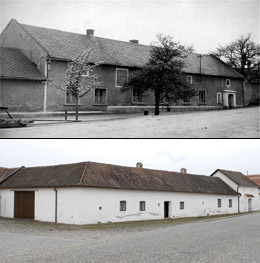
The museum is looking for a new use for Gottwald's birth house
 |
| In the upper photo, the original farm of the Štark family, in the lower the 'birth house' of Klement Gottwald after reconstruction. (source: cestovani.idnes.cz) |
"It is a question of what happens next. Whether to try to create an exhibition from the times when it had an ideological purpose, or to resign from that," Korvas said. According to him, creating an exhibition about Klement Gottwald that would engage contemporary audiences is very difficult. Documents are missing from the archives that could portray the former communist president as a person and shed light on the internal motivations of his behavior. "You cannot get to know a person through several resolutions of a congress," Korvas stated.
He believes that historians should address the figure of Gottwald, particularly as witnesses of events surrounding the president and his cult are gradually passing away.
The so-called Gottwald's birth house in Dědice is a protected monument. Although it was transformed into a poor rural house in the 1950s, it resembles a dwelling that used to exist in the Vyškov area in the 19th century but has not survived, said Korvas. Today, the house is mainly filled with archaeological finds from the Vyškov area, which the museum is legally required to collect. It is expected to become free in two years. At that time, the former exhibition pavilion that borders the house will be converted into a modern repository.
"For this year, we are planning the first phase at a cost of 5.5 million Czech crowns," Korvas stated, adding that the reconstruction should be completed next year. Half of the new archival space will be used by exhibition curators, while the other half will serve as a repository for archaeological finds. The new repository will be completely separated from the house and will have its own electrical and gas connections. "It would be possible to consider offering the house to the city, selling it, or finding some use for it," said Korvas. However, as an exhibition space, the house is not the most suitable, primarily due to its distance from the center of Vyškov.
> How the farm became the poor Gottwald cottage
The English translation is powered by AI tool. Switch to Czech to view the original text source.
0 comments
add comment











